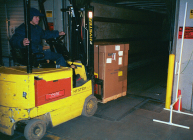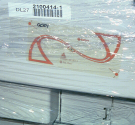April 23, 2003 – Third-party logistics provider Lionize Logistics has completed a pilot deployment of an RFID system that covers nearly 100,000 square feet at one of its two warehouses and distribution centers. The system automated the receiving of electronics goods and exceeded the company’s expectations. Lionize plans to expand the use of RFID throughout its supply chain.
Atlanta-based Lionize is using RFID to replace bar codes for inventory tracking, and its initial pilot implementation, which has been up and running since February, has already proved capable of dramatically cutting the labor needed to process, manage and distribute its electronic office equipment and related parts and supplies.
The pilot system was designed and implemented by RFID systems integrator Xterprise using RFID labels and readers from Alien Technology. The readers feed data to a new RFID data collection module developed by Crimson Software to work with the Crimson Warehouse Management Systems that Lionize was already using.
Previously, Lionize staff receiving goods had to unload each pallet and scan a bar code on each box before products could be moved into the warehouse. A typical delivery could have as many as 28 palettes with 40 boxes on each. The pilot showed that as many as 20 boxes of supplies could be automatically received as pallets pass through the warehouse dock door. “It cuts the unloading time from three hours to one,” says Brian Sweeney, managing partner of Lionize Logistics.
The system also reduced errors and the cost associated with reconciling errors with customers. But the full benefit of the switch to RFID has yet to be realized. During the pilot, Lionize staff had to fix RFID tags to products as they were unloaded. Now, Xterprise says the plan is to work with Lionize’s suppliers, as well as its customers, to adopt the same technology. “The pilot has shown how to better automate the supply chain, and there is a push to extend this to Lionize’s other distribution center as well as their customers,” says Dean Frew, president of Richardson, Texas-based Xterprise.
The system uses 1.75 inch by 4 inch UHF (915 MHz) RFID labels from Alien. Because the labels on the packages may be in any orientation to the reader, Lionize used tags with an S-shaped antenna, which is designed to be less orientation-sensitive. The company also used circular-polarized antennas to create a broader read field and maximize the chances of reading the tag. (A linear polarized antenna directs the RF energy more narrowly to provide greater range and penetration.)
Each RFID label costs around 45 cents. But the savings from speeding up the receiving process makes the investment worthwhile, according to Sweeney. “The cost is not a concern,” he says. “The ROI time on a tag is less than is an hour.”
The tags can be read from nine feet away on finished office products, such as copiers and fax machines, and on labeled boxes of supplies such as printer cartridge and toner. As well as deploying the RFID system throughout its operations, Lionize says it has further plans for RFID technology. The company is considering equipping its forklift trucks with RFID readers. That would enable the company to eliminate monthly inventory cycle counts and twice-yearly physical stock counts because inventory would be updated continuously.
“We are always going to be discovering things to use RFID for that we never thought about,” says Sweeney. “The learning curve is going to be near vertical.” — By Jonathan Collins



